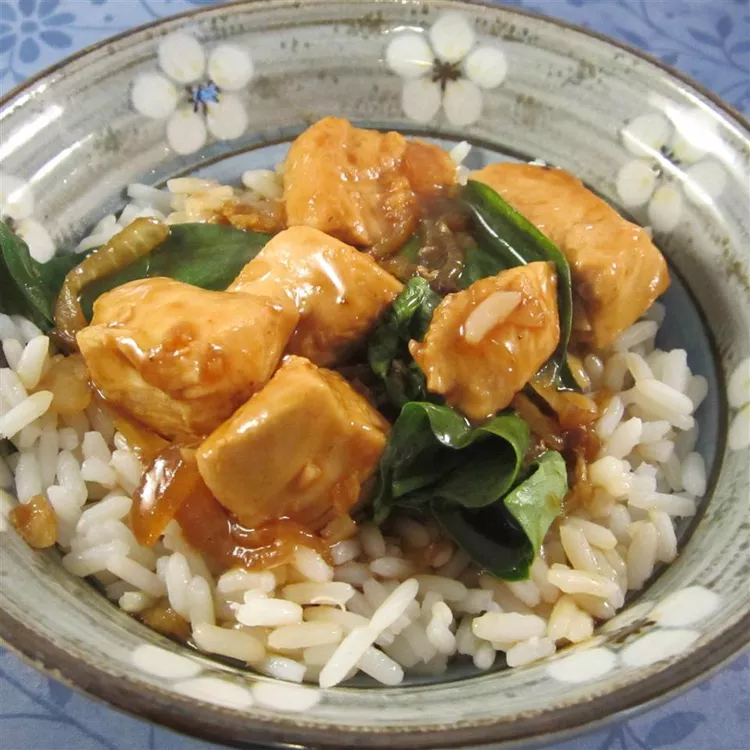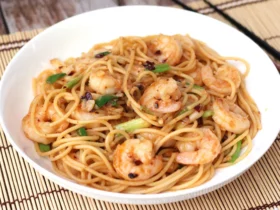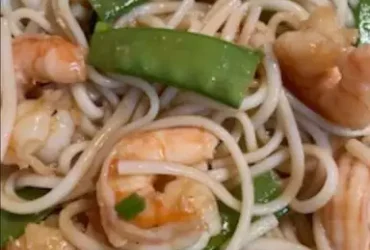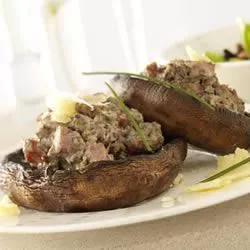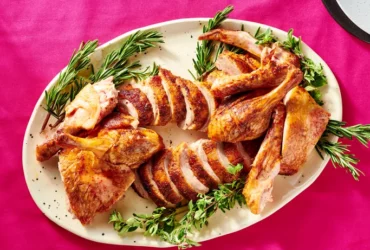Background and History
Thai Basil Chicken, known as “Pad Krapow Gai” in Thai, is a popular street food dish in Thailand. This dish is a perfect example of the balance of flavors that Thai cuisine is famous for—spicy, savory, and aromatic. Traditionally served over jasmine rice and often topped with a fried egg, this dish has become a favorite for its simplicity and bold taste. Thai Basil Chicken is a quick stir-fry that incorporates holy basil, a key herb in Thai cooking, which imparts a unique peppery flavor that distinguishes this dish from other basil chicken recipes.
Ingredients
- 1 lb (450g) boneless, skinless chicken thighs, cut into small pieces
- 2 tablespoons vegetable oil
- 5 cloves garlic, minced
- 3-5 Thai bird’s eye chilies, chopped (adjust to taste)
- 1 large onion, sliced
- 1 red bell pepper, sliced
- 2 tablespoons soy sauce
- 1 tablespoon oyster sauce
- 1 tablespoon fish sauce
- 1 teaspoon sugar
- 1 cup fresh Thai holy basil leaves (or Thai sweet basil if unavailable)
- Jasmine rice, cooked (for serving)
Useful and Interesting Facts
- Thai holy basil: Unlike sweet basil, Thai holy basil has a spicy, peppery flavor. It’s the star ingredient that gives this dish its authentic taste.
- Chilies: Thai bird’s eye chilies are very hot. Adjust the quantity to suit your heat tolerance.
- Quick cooking: This dish can be prepared in under 20 minutes, making it perfect for a fast and satisfying meal.
Instructions
Serves
4
Time
10 minutes (preparation)
Cooking Time
10 minutes
Cooking Instructions
Preparation
- Mince the garlic.
- Chop the Thai bird’s eye chilies.
- Slice the onion and red bell pepper.
- Cut the chicken thighs into small pieces.
- Rinse and pat dry the basil leaves.
Cooking
- Heat the vegetable oil in a large skillet or wok over medium-high heat.
- Add the minced garlic and chopped chilies, stir-frying until fragrant, about 1 minute.
- Add the sliced onion and red bell pepper, stir-frying for another 2 minutes until they start to soften.
- Add the chicken pieces, cooking until no longer pink and slightly browned, about 5-6 minutes.
- Stir in the soy sauce, oyster sauce, fish sauce, and sugar, mixing well to coat the chicken and vegetables evenly.
- Add the fresh basil leaves and stir-fry until wilted and aromatic, about 1 minute.
Serving
- Serve the Thai Basil Chicken hot over a bed of jasmine rice.
- Optionally, top with a fried egg for an authentic touch.
Nutrition Facts (per serving)
- Calories: 320
- Protein: 25g
- Fat: 18g
- Carbohydrates: 15g
- Fiber: 2g
- Sugar: 4g
- Sodium: 900mg
Notes
- For a milder version, reduce the number of chilies or remove the seeds.
- You can substitute chicken thighs with chicken breast if preferred, but thighs offer a juicier texture.
- If you can’t find Thai holy basil, Thai sweet basil or Italian basil can be used, though the flavor will be slightly different.
Allergy Warning
- Contains soy (soy sauce), shellfish (oyster sauce), and fish (fish sauce). Ensure all sauces are free from allergens specific to your dietary needs.
Enjoy your quick and easy Authentic Thai Basil Chicken, bursting with the vibrant flavors of Thailand!
Is Thai basil used in Indian cooking?
Thai basil is not typically used in traditional Indian cooking. Indian cuisine generally uses other herbs like cilantro, mint, and various types of curry leaves for its distinct flavors.
What are the two types of Thai basil?
The two main types of Thai basil are Thai holy basil (Bai Krapow) and Thai sweet basil (Bai Horapa). Holy basil has a spicy, peppery flavor, while sweet basil is more similar to Italian basil with a hint of anise.
What is basil chicken made of?
Basil chicken is made of boneless chicken pieces stir-fried with garlic, chilies, onions, and bell peppers, seasoned with soy sauce, oyster sauce, fish sauce, and sugar, and finished with fresh basil leaves.
What is the best basil for Thai cooking?
The best basil for Thai cooking is Thai holy basil (Bai Krapow) due to its unique spicy, peppery flavor that is integral to many Thai dishes.
What is the difference between normal basil and Thai basil?
Normal basil, or sweet basil, has a sweet, mild flavor with hints of clove, while Thai basil has a spicier, more robust flavor with notes of anise and licorice, making it distinct in taste and aroma.
Is Thai basil healthy?
Yes, Thai basil is healthy. It is rich in vitamins A and C, and contains antioxidants, antibacterial properties, and compounds that may help reduce inflammation.
What is the closest herb to Thai basil?
The closest herb to Thai basil is regular sweet basil, though it lacks the spicy, anise-like flavor. Adding a bit of star anise or fennel can help mimic the taste.
Can you eat Thai basil raw?
Yes, you can eat Thai basil raw. It is often used fresh in salads, garnishes, and as a topping for various dishes to add a burst of flavor.
How do you make Thai basil taste like regular basil?
To make Thai basil taste more like regular basil, you can blend it with a bit of sweet basil. However, the distinctive anise-like flavor of Thai basil will still be present.
How to use Thai basil in cooking?
Thai basil can be used in cooking by adding it to stir-fries, soups, curries, and salads. It is typically added towards the end of cooking to preserve its flavor and aroma.
- Best Lusha Alternatives for 2025 - April 22, 2025
- Best Overloop Alternatives for 2025 - April 22, 2025
- Best 6sense Alternatives for 2025 - April 22, 2025

